So there you are, all stressed out because of a big final exam tomorrow. You are confident you can pass the multiple choice part. If that was all the exam consisted of, you could be out having a drink and getting a peaceful night's sleep. Sadly, there are rumors of an oral exam. All alone on stage with various professors asking questions that you can't really prepare for. Well, if someone told you that students that skipped the oral exam not only passed, but were actually found to master the topic better than those that took the oral exam. Well, no brainer right, just skip it. I can't help but think of it in these terms when I'm told about unfiltered wines.
Increasingly in recent years I've seen wine labels and tech sheets extolling the unfiltered & unfined nature of the wines. Unfined, sure, so far I've been able to avoid throwing eggs in my Cabernet or pouring bull's blood in your syrah. If you are confident that you picked your grapes at the right time, made and aged the wine soundly, not needing to fine makes perfect sense in small lot wine making. Filtering to me is an entirely different issue. I can't claim to tell you that one train of thought is better or worse. But after years of thinking, reading, asking and doing, I am fairly confident that neither is always better than the other.
Give me a second here and let me tie back into that first paragraph. Bottling is the final exam for the winemaker. After 1-3 years of working with a wine, you mark a date that you are putting it in bottle. After that, you don't get to play with it ever again. It is marked as ready for the world, and you send it out to meet people. Thus those final couple of weeks are a flurry of nerves and activity. The blending trials are sure fun, and make one appear to be an actual winemaker. Dressed nicely while standing around contemplating glass after glass until you feel you've got the best final blend you can make.
Next comes the forklift driving, hose dragging and barrel washing that require less fancy outfits and are more actual work. This is the part of the job you don't wax poetic about during a winemaker dinner. And then there is filtering, the job done 99.9% of the time by assistant winemakers or cellar crew. Let me tell you, nobody enjoys filtering. If you've worked with one, you would know. They take a long time to prepare, (pumping wine through wet cardboard and avoiding a TCA like wet cardboard flavor or aroma takes a bit of magic) then they inevitably clog up. You have to back flush and eventually prepare a new set of pads. The pressure builds up to scary amounts and you hear strange cracking and popping noises making you feel a hose or the pump could explode at any moment. And worst of all, you lose a certain percentage of your wine dripping off the pads. Man, if not using a filter makes the wine better, count me in. That's a couple days of my life back. Plus I could change back into my dry pants and Patagonia fleece vest and walk around the cellar like a proper winemaker. Leg up on a barrel, wine thief in hand, gazing thoughtfully into the distance....but I digress. Quite often, as troublesome as it is, I feel like filtering is often a necessary endeavor.
To understand why, you first have to think about what is being filtered out of the wine. This is not a charcoal filter that is going to strip the wine bare. The filter is a cellulose sheet, kind of like a super heavy duty coffee filter. So you push the wine through the filter sheet, and the large impurities are taken out. These filters are not so fine that they remove the molecules that are associated with flavor or taste. What we're talking about are the dead yeast and bacteria, the byproducts of primary and secondary fermentation, that are suspended in the wine solution. This is what forms the thick mud like lees at the bottom of barrels of aging wine. Trust me, I've cleaned enough barrels and fermentation tanks to have a little lees end up in my mouth. These are not the flavors you're reading about in any wine critics tasting notes of fine wine. They also can make the wine appear cloudy, a massive fault in a bottle that tells me basically the winemaker doesn't care all that much.
There are times I can avoid filtering. If I have been a busy beaver winemaker and racked the wine many times over. This means pumping the clear wine off the top and leaving the lees in barrel. If you do this a bunch of times, all those impurities will have naturally dropped out of solution, so the wine for the most part will be clear and free of most large impurities. If this is the case, well no need to filter. Gravity has done the work for you. But I don't rack my wines that often, usually just 1-2 times over wine's lifetime in the cellar. I feel lees is the wine version of the primordial soup, and all sorts of interesting things are taking place in there. Over the years in barrel, flavor, aroma, and mouthfeel components are being created in the lees and released into solution. Almost all barrel aged white wines are made like this. This along with malic acid and cold stabilization is why you almost never see unfiltered white wines. I strongly believe red wines can benefit from sur lie aging just as much as whites.
The sacrifice I have to make for these lees components though is a couple of long, cold, wet days staring at a pressure gauge, getting that wine all cleaned up and ready for it's introduction to the word.
Picking of fruit for 2011 is now done. Last week was a non-stop pick and process fest as a big storm was heading into town and things needed to get off the vine before the wet weather arrived.
Being a winemaker means you are obsesed with weather. This time of year, the weather you are most concerned with is rain. When rain will arrive, and how much will come down will make your picking decisions for you. So trying to predict what is on the way is of utmost importance.
In addition to basic weather reports, and the fancy wine grape based weather report we get from the Paso Robles Wine Country Alliance, there are a couple of other inputs I use. The mostly I use the Pacific Surf Forecast. Whereas farmers are mostly concerned with what is happening right outside, surfers are more concerened with what is happening 1000's of miles away. If you read this stuff often enough, you start to see how weather, for example, off the coast of northern Japan can affect weather here in California. Understading the global trends and patterns of weather can often give you a good idea of what is comming your way well in advance.
Lastly, and most accurate, is this weather device for rain and cold:
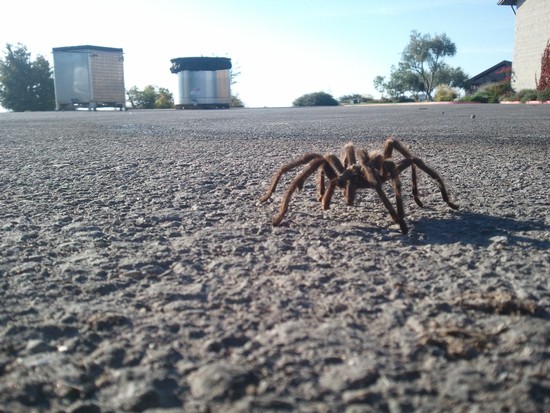
Whenever these dudes start marching around the winery, I know something is up. I don't know if they are heading for high ground to stay dry or warm or what. But once I see a bunch of this kind of action, it's time to talk with the vineyard crew. This was the Saturday before last. I banked on this guy knowing what was up and called for 5 straight days of picking everything we had left on the vine. Worked out as we got done Thursday night and it poured all Friday, Saturday and Sunday. So thanks to my weather guy above for the heads up!
THe Truth Is Rarely Pure And Never Simple -Oscar Wilde
For the past few years, the great debate in the stuffy world of wine has been alcohol. It is a topic that people feel passionately about. It is also one of those rare topics in the discussion of wine that has actual concrete parameters that can be discussed. Thus it is a great thing to base symposiums and discussion groups around.
I for one could care less what the alcohol percentage is of a wine. Either I enjoy it or I don't. But the number is printed on the label and gives ammunition for all with a bone to pick. The most common bone being picked is that high alcohol wines are a stylistic decision made by lazy winemakers. People who dislike high alcohol wines claim it as evidence as an attempt to make big flabby overripe wines to trick some critic into giving out a big numerical score to the wine.
Like I have discussed earlier in this blog, I pick mainly by using my natural senses. I like to look at the chemistry just so I know what I'm getting myself into as far as the ferment goes. But the decision as to is the fruit ready to come off the vine, I trust mainly my sense of taste, touch, and sight while walking the vineyard. (If I am smelling or hearing the grapes on the vine, that is an indication that I should have picked yesterday.)
One of the big reasons I have decided to swing my decision making so far into one camp is due to the fact I make wine in Paso Robles. This is a unique place making unique wines. If there is a textbook out there that explains making wine in Paso, I haven't read it yet. Most accepted thought on winemaking was established elsewhere, thus I always take lessons from afar with a grain of salt. For a case in point, let's look at the 2011 harvest.
Things are all over the map this year. Early ripeners are developing late and vice versa. I picked some Tempranillo last week that was 23.8 Brix and 3.95 pH. Sure that's just the low acid nature of Tempranillo, but even though it will end up being around just 13% alcohol, the fruit was plenty ripe and I didn't want to let it hang another day. Then this weekend we picked some classic Paso Robles fruit.
Our Kate's Vineyard Zinfandel is always one of my favorite picks of the year. The vines are not overly vigorous for Zin, and produce amazingly complex wines. One of the main reasons for the complexity is high acid and tannin in the must even when pushed for ripeness. Here is the brix measurement after a 4 day cold soak.
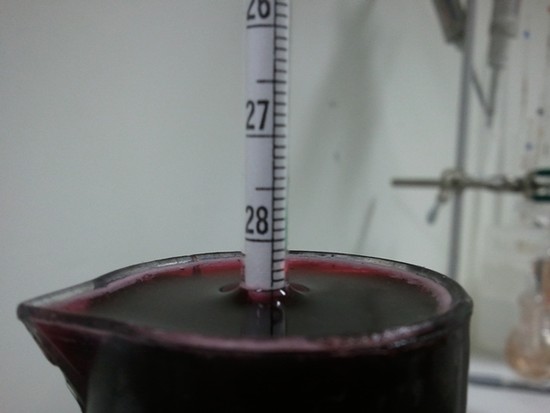
28.5! There I go chasing big scores with my big lazy overripe jammy Zin that is going to taste like some Virgin Islands cocktail. If I was making proper wine, I would be pushing for balance, restraint, nuance, complexity. I would have picked it 3 weeks ago at a respectable 25 brix. Instead I'm just going for power to win over some critic who is never going to taste this wine anyway.
Well before we start jumping to conclusions; let's look at some more evidence. I can't have you virtually taste this, so I can't prove that this wine is going to be incredible. But check out this photo:
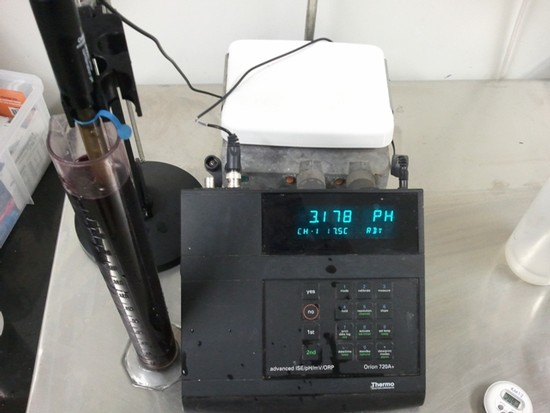
Wait, what? 3.178 pH. My favorite was the sample I took 2 weeks ago that was 26.2 Brix with a 2.84 pH. So there I go, trying to impress the euro snobs with my austere acidic wines that will take years of ageing to be drinkable.
So who am I making this wine for? Well, I'm making it for the people who have tasted our Zin and love it. Sure these numbers are off kilter, but this must tastes right it its own peculiar way. Big and ripe but with amazing backbone, color and tannin to bring everything into proper balance. Our 2007 Zin had very similar chemistry and it sold out in about 3 weeks. If I could get the numbers to be more traditional, but had to sacrifice what this must tastes like, I would never go for that.
Next time someone wants to look at the % number on the wine label and pontificate about the winemaker's intention, tell them this little story. This world is not always so black and white.
As a winery grows, the most pressing concern on the wine making side is how to expand production without loss of quality. The key reason quality can differ as growth takes place is the choice of new vineyards. In that spirit, it has taken 3 years of patience to find another Chardonnay vineyard here in Paso Robles that we felt comfortable with. The 2011 vintage marks our fist attempt to get to know this place. (People commonly claim that the French word Terroir has no translation to English, I disagree. To me it means place, as in "It's almost as if that building is of this place." Writing this blog has reminded me that the English language can be as beautiful as any if used with consideration.)
The only comparison I can find to this type of nervous excitement is a first date. When all possibilities are still available, your dreams framing what could be.
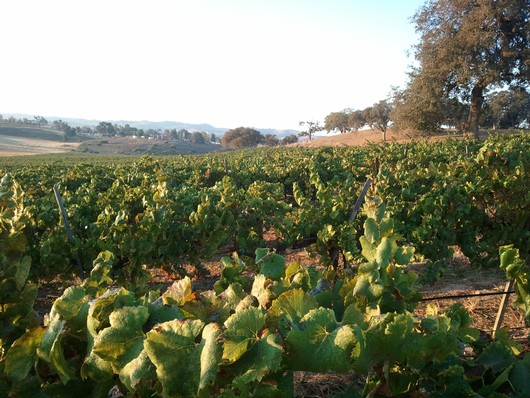
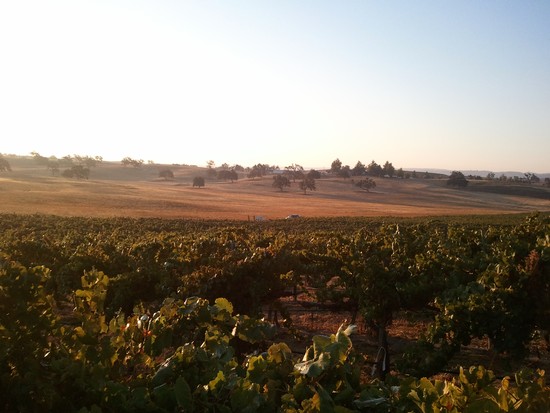
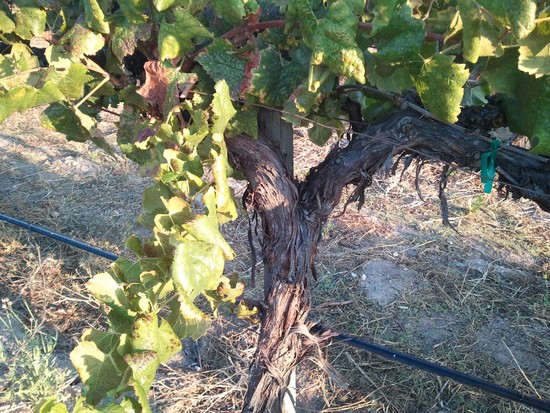
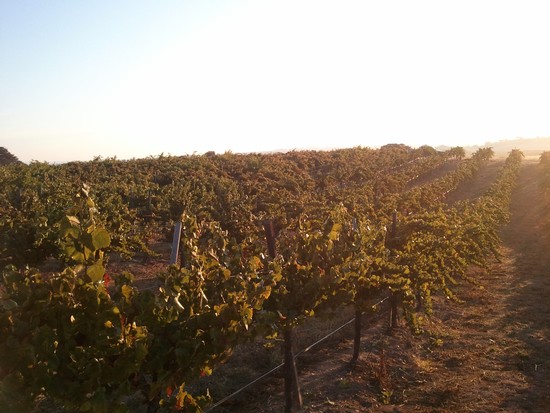
The unpredictable nature of the harvest allows for all sorts of opportunities to the open minded winemaker. The small blocks we farm are tailor made for trying whatever experiment comes to mind during crush. And then, if you let your mind wander, one new idea leads to the next.
This year I wanted to try something a bit different with the Chardonnay. For the most part, every year we harvest the Chardonnay and the clusters are added directly to the press. The juice is pressed from the skins and the wine made from fermenting the juice with no infulence from the skins. I've tasted a few "skin contact" white wines recently and was intrigued. A "Skin contact" white is making white wine exactly like you make red wine, fermenting on the skins as opposed to just the juice. I'm not exactly sold on the concept as I feel the goals of making white and red wines are not necessarily the same, so techniques should not be the same. Never the less, I encourage you to go find these wines. Sometimes they are refereed to as "orange wines" due to the slight coloring the occur. Another way to find them is to look for "skin contact" or "on skins" in the production notes. It is always interesting to taste something that is done in a different way, a great example for tasting what skins add to the wine.
What I was interested in about fermenting white wine on the skins was not the skins, but the potential for carbonic maceration. I seldom "crush" berries during harvest. That is, use some mechanical device to crack the grape skins and release the juice. I use a lot of whole berry fermentation. Leaving the berry whole encourages a slightly different form of enzymatic fermentation within the grape itself. This type of fermentation is known to produce a more pronounced fruit character in the finished wine. Those of you who have tasted Paso Robles wines know that they tend to be big in all aspects. Using this technique to increase the fruit character allows the finished wine to remain balanced, not clunky or harsh due to the acid or tannins dominating.
In this spirit, a section of our estate chardonnay was destemmed after harvest, and the whole berries allowed to rest in our cold room under a blanket of CO2. After 48 hours, the grapes were pressed and the the juice treated the same as our whole bunch pressed Chardonnay. We'll see some time in spring how the flavors differ from the methodology.
A bonus feature of this method is that we ended up with a bin of chardonnay skins. This allowed for the next little experiment. Some of these skins were tossed into one of the Pinot Noir ferments that was just getting started.
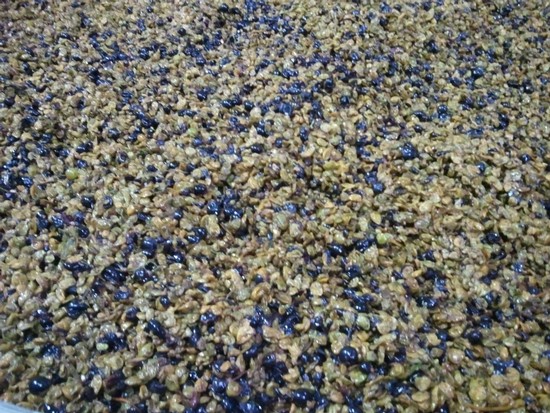 It has been rather common to add Viognier skins into Syrah ferments, adding delicate mid-palate flavors to the heavy Syrah. Pinot Noir is a much more delicate varietal, so it will be interesting to see what the Chardonnay skins add to the flavor. Now, if I had a 20+ ton tank of Pinot Noir fermenting away, it would be rather insane to just chuck in the Chard skins and see what happens, because there is no guarantee that this will work. It might be beautiful, it might be horrible. When you have several 1.5 tons ferments going on, the risk is not that great. The small size of our ferments allows for this exploration without risking the farm. So, we'll see what happens. I'll keep you posted on any other ideas that pop up over the next couple months.
It has been rather common to add Viognier skins into Syrah ferments, adding delicate mid-palate flavors to the heavy Syrah. Pinot Noir is a much more delicate varietal, so it will be interesting to see what the Chardonnay skins add to the flavor. Now, if I had a 20+ ton tank of Pinot Noir fermenting away, it would be rather insane to just chuck in the Chard skins and see what happens, because there is no guarantee that this will work. It might be beautiful, it might be horrible. When you have several 1.5 tons ferments going on, the risk is not that great. The small size of our ferments allows for this exploration without risking the farm. So, we'll see what happens. I'll keep you posted on any other ideas that pop up over the next couple months.
I firmly believe there is single most important job for a winemaker, deciding when to pick the fruit. The best a wine will ever be is the moment you pick it. All you can hope to accomplish is to lessen how much it degrades. The techniques you read about in the produciton notes of your favorite wine cannot improve the wine, they represent only our best efforts to fully capture and express what is within the fruit. Since determening the pick is such an important task, I'm surprised how little attention it gets.

The how and why of picking dates is different for each winemaker. The separate routes taken to this end represent most of what is the underlying character of the wines produced by different winemakers. The routes are plentiful due to the mass of information available and the varied interpretations of that information.
You can break up most of the information into two rough categories, vineyard observation and lab data. The safe thing for the modern winemaker to say is that both forms of information are equals. But from what I see, most people lean towards one or the other. On one end you have the winemaker who reads only spreadsheet charts and can track the exact optimal moment of balanced sugar, acid, polysaccharides, phenolics, anthocyanins, etc. If you have 5,000 acres of fruit you are responsible for, it is pretty impossible to go "walk the vineyard" and decide how it's tasting. On the other extreme you have the winemaker who eats the fruit in the vineyard and looks at the vine for changes in shoots, leaves and stems. This really works best when you have a single vine in your backyard. So where you ask do I find myself in this continuum?
Being an organic chemist by training and trade, one would expect me to be most smitten with the data avalanche of the well-stocked winery lab. At first, that made most sense to me. But the more harvests I undertake, the more and more the vineyard and tasting the fruit have started to dominate my decision-making. The main reason I have made this change is a newfound belief that this decision is what we humans are designed to do.
When I was working in biotech as a multi-step organic bench chemist, most of the PhD's working there were Soviet trained. With this Soviet training came some "old school" techniques. The PhD I worked most closely with often made decisions about the success or failure of a reaction base on smell. The sane thing to do is to run a sample in the GCMS. But this takes about 20 minutes start to finish in a busy lab, and smelling the reaction is instant to the trained chemist nose. In fact, the history of organic chemistry pre-dates the analytical tools of the lab because early chemists could look at, listen to, feel, smell and taste their reactions. These senses of ours amazingly powerful, they easily rival large instruments costing hundreds of thousands of dollars. And they are never more powerful then when being used for their actual purpose.
The tasting of ripening fruit is an example of one of those actual purposes. Think about your sense of taste for second. Why should you want to taste things, what's the point? Well, first and foremost it immediately tells you if something is good or bad to eat or drink. If you could not taste salt, how could you tell if water was fresh and drinkable, or like the vast majority of water available to you, salty and dangerous. Without sour, bitter, sweet and Umami (wait, what? I think I missed a memo.) how could you tell if fruit is going to be a nutritious snack or a belly ache waiting to happen? This to me is the whole point of our ability to taste, so we know when fruit is good to eat. Lucky me, to have such an amazing tool to help me with my job.
The whole process is incredible to me. The vine wants to spread its seeds around. It decides to surround its seeds in a tasty treat so that animals will eat them and the seed will travel with them. The danger for the plant is the animal wanting to eat the fruit before the seed is ready. So while the seed matures, the fruit needs to taste unpleasant to the animal. Thus the young grape is extremely sour and bitter with very little sweetness. Once the seed is ready though, the fruit quickly loses bitterness and acidic flavors and becomes more and more sweet. At a certain point there is a perfect balance that may not be the exact best moment to eat the grapes, but is the exact best moment to make perfectly balanced wine.
Standing in the vineyard, eating grapes in the morning, the tuned winemaker sense machine can accurately determine brix and pH along with skin tannin and color and many other chemicals. It is a fun test to make a best guess as to the pH and Brix when tasting fresh must. The winemakers I learned from would have no problem producing a number that was within 1 Brix of a hydrometer and 0.2 pH of a probe.
There are even some things that only tasting the fruit can give you. Like tasting the difference between crisp and mushy watermelon, the consistency of the pulp is one of those vital things that I have never seen determined in a lab. (Note to self, build a little spring tension device that produces a "firmness" number, sell to wine labs, retire.) Things like cane and stem lignifications and leaf color change can only be determined by actually visiting the vine. I cannot see how it is possible to be absolutely confident you are picking the fruit at an optimal moment without spending time in the vineyard using your senses. Because really, that is what they are there for.
I've been a bit quite lately. I was assuming most people don't want to read lengthy discussions on proper tank and bin cleaning techniques. Or perhaps I could have made a video of me and cellar team hand labeling Estate Cabernet. Also a webcam following around Rory as he topped barrels and checked sulfur levels could have been exciting. Instead, I gave you nothingness. But that is all about to change.
Yes, it is happening. Fruit is arriving. And probably won't stop arriving for a long time. The York Mountain Pinot comes off on Monday. We are ready. A heat spell hit this week with contstant temperatures in the 100's. Not a good time to be picking a thin skinned grape like pinot that can dehydrate quickly. So we wait out the heat, give the vines a couple of days to recoup in the onshore foggy breaze from the mighty Pacific. Then we go and harvest before sunrise. So nothing to do this weekend except rest, relax, contemplate, prepare, then go..
"Well the Universe is shaped exactly like the Earth . If you go straight long enough you'll end up where you were." - Isaac Brock
August is the month of pre-harvest rest and reflection in the cellar. With this in mind I headed out to the local movie theater last night to catch a film with a friend. This writing I guess is an attempt to explain why I loved Bill Cunningham New York, a documentary about the New York Times fashion photographer. The unadulterated passion for and mastery of subject, the honesty, the modesty, these are all the characteristics I can only hope to bring to my own work. I don't think I’ve seen a more inspirational embodiment of my ideal in this funny little world we must work in. Sacrifices of life that must be made to keep to that ideal are too vast to follow myself, but I love to be reminded that there are so many paths to so many pinnacles.
It also reminds me of one of the underlying features of wine and wine making that I love so, the all encompassing nature of the craft. Try as I might, it would be extraordinarily difficult to apply lessons from the life of a Spartan fashion critic to my previous path of synthesizer of research pharmaceuticals. With wine though, whatever idea presents itself, there seems to be a relationship one can find to expound upon. One of the sub-currents of the film that fascinated me was that of the cyclical nature of the fashion world. How styles and designs come in and out of being the leading edge of the day. Along with that, one begins to see the cyclical nature of all those industries that are based upon aesthetics and taste. Styles of dress, art, writing, music, film, design, architecture and yes, wine all seem to be progressing in a self-referential way that by nature must look back upon itself as it moves forward.
Beyond the obvious agrarian cycle of wine production itself, there are other cycles in the wine industry we must confront. Varietals go in and out of vogue. What is considered balanced is a moving target because it has no true definition, being rather one of those Justice Potter Stewart subjects that you know when you taste it. Regional styles get acclaim, then become passé and fade. The techniques of the winemaker, from the treatment of the fruit to the materials of the containers are all in constant flux. From this we get the ideas, trends, and styles of wine that come, go, and then return.
This all flashed through my mind today when a taster asked me what "my goal was" when making the 2007 York Mountain Cab. I was stuck on the basic response of "just trying to make the best wine I possibly could." (Sadly, in all honesty, this is still the best answer I can give without writing a long blog post about it!) But so much more was at play than just trying my best. The hundreds and hundreds of discussions and reactions I've been privy too involving our 2005 and 2006 Cabs obviously had some say. The lessons from the winemakers I learned from and the opinions of friends and peers all manifest themselves somehow. Even the monthly tracking of inventory depletions creates a most stark criticism which is difficult if not impossible to simply ignore. All these factors create the context from which my personal expression comes forth.
This frees me from worrying too much as we plan for the emmient harvest. The pre-season is done, it is time for the real games to begin. I've spent the last 9 months in reflection of all my previous harvests and in adding new life experience which are bound to bring new influence to what will come. Decisions about ripeness, acid, brix, stems, soaks, temperatures, extractions, pressing, oak, racking, oxygen, which beer to drink while hosing down the destemmer must all be made. All of which are choose your own adventure questions leading you to a mysterious outcome. The past is our only guide, thus in showing the way will make itself known. It cannot return in whole though, being more the candle casting light unto and creating shadows of the current vintage. Just like life itself, despite all the best plans and forethought, making wine is an act of constant improvisation.
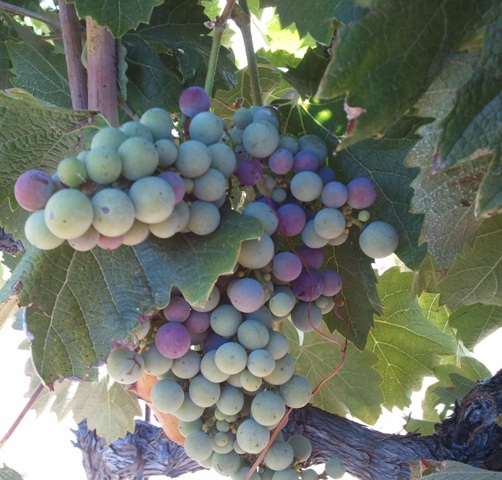
This fact, along with the rarity and one time nature of the vintage create such a unique excitement. A new start, all possible outcomes are again out there to be reached. This explains the butterflies in the stomach feeling that walking in the vineyard invoked this morning. The arrival of veraison, like the firing of a starting gun has officially set harvest in motion. It is time again to create the best possible wine we can, and I can't wait to try.
One of the side jobs that comes with becoming a winemaker is the position of chief of all family wine questions and situations. As someone who just plain loves wine, I’m not always the best suited for this job. When a family member does a bit of research and tells me, “Oh, let’s hold off on the Chardonnay right now because I heard that you can’t drink it with the salad dressing I used.” I can tell that they really don’t care, that they are just worried that I will look at them scornfully as they serve me the evil mixture of wine and vinegar. As if people expect me to fly off the handle yelling, "How dare you ruin the sanctity of my wine that I perfectly crafted. This meal is RUINED!" Instead, I usually reply with something like, “You know, that might be technically true, but who cares. Never hold off on drinking wine, bad pairings can be just as fun as a good one. You can see what difference the food makes in the way the wine tastes." This is a great way to truly understand food pairing.
Wine's relationship to our palates fascinates me endlessly, so I’m not one to dogmatically follow the rules of food and wine. Like most trained scientists, I feel there is just as much to learn in failure as there is in success. Sadly, my offhand dismissal of hard and fast rules just makes everything more confusing for my family.
These situations always get me thinking about why wine can be so confounding to those first exploring it. I think people are scared that they will demonstrate some form of wine ignorance by flubbing a basic rule. Well, rules like these are meant to be broken indeed. The world of food and wine is so complex, simple rules should only be the roughest of guidelines. As an example wines are often described as being "food friendly". I guess this is said implying that some other un-named wine is unfriendly or just plain rude. Since wine is so completely intertwined into the culinary experience, this has to be one of the harshest critiques possible of a wine. The problem that immediately comes to my mind is this: What does the critic in this case mean by "food"?
When I lived in San Francisco, a typical 8pm question was, “What should we eat tonight?” I know this is a common problem in homes throughout the world, but the seemingly endless choices made available in my neighborhood invoked that same feeling of hopeless confusion as when choosing a toothpaste.
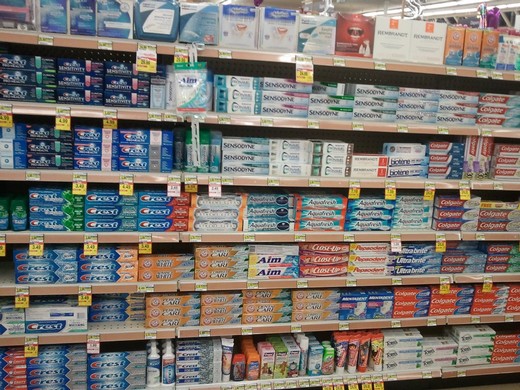
Anyway, here is just a sample of the choice of restraunt styles that were within a 4-minute bike ride of my front door:
American, New American, Southern, BBQ, Californian, Cajun, Seafood, French, Italian, Vietnemese, French-Vietnemese, German, East German, Hipster German, Pizza, Southern Indian, Northen Indian, Pakistani, Chinese, Nepalese, Cambodian, Thai, Ethiopian, Senegalese, Moroccan, Spanish/Tapas, Peruvian, Nicaraguan, Mexican, New Mexican, Tacos, Burritos, Vegan/Raw, Cuban, Japanese, Mediterranean....(Man, now I need to spend a week eating in the Mission)
The idea that there is some formula out there that x and y features of wine make it good with "food" seems totaly absurd. I don't care what the pH, TA, tannin, alcohol, balance, ten-cent wine descriptor, you can find a food that works for you with pretty much any wine. I've met people who swear by sushi and whiskey! Not my ideal pairing, but if you love it, anyone who tells you otherwise can take a walk. When one combines the entire spectrum of sustenance with all the styles and characteristics of wine, then throws in the full range of human taste and experience, I think you’d have to be a Numberwang champion to figure out all the possibilities.
So take this as a challenge to disregard much of what you’ve read or heard and just go exploring. Eat at places that are passionate about what they serve and express a unique point of view. That passion will lead them, and in turn you, to all sorts of interesting and unexpected places that simply following “the rules” would steer you away from. The role of the experts should not be to confuse you and limit your choices, but instead be a role of expanding and leading you to try something you might otherwise avoid. Any sommelier will tell you the greatest triumph in pairing is the success of the unexpected. Don’t be afraid of failure or of some snobby upturned nose at a bad pairing. Try anything and everything with the full confidence that failure and success are both wonderful outcomes when it comes to wine and food. This more than any book, video, magazine, or blog will lead you down the path of understanding your unique palate.
I hate to dampen my general wine know-it-all credibility, but the last time I was in France, the Euro was just an exchange unit. The Franc was still the currency of notes and coins. My joy for and impression of the French was greatly increased upon receiving my first 50 franc note. What a country, the Little Prince right there in my hand. For whatever reason, my country would never embrace Max on the 50, and I feel we suffer a bit for this. A culture that embraces the importance of its artistic contributions right along with the political is a grand and confident culture indeed.
This image did its job, and I tracked down a different book by Antoine de Saint-Exupéry at an English language book store and learned why France would hold this author in such high regard. I was forever changed by a quote I found in that book. A quote that I would suspect came from Japan or Sweden, but in fact was French. “Il semble que la perfection soit atteinte non quand il n'y a plus rien à ajouter, mais quand il n'y a plus rien à retrancher.” Translated in the book I read as “Perfection is achieved, not when there is nothing more to add, but when there is nothing left to take away.” This hit home with my own fledgling design esthetic and is still with me now when I consider making white wine.
I get a lot of surprised looks and disagreement when I tell people during conversation that I feel making white wine is much harder then red wine. I don’t mean physically harder, as minus the punch downs, whites are quite a bit less taxing on the body. But as for making decisions that must be correct, whites are much more demanding. I’m not the type of winemaker who will go on and on about how my immense cellar skills will take terrible fruit and craft perfect wines. I am of the firm belief that the ceiling for the quality of a wine is set the second you pick it. My experience is that my chief responsibility as winemaker is to not allow the wine to weaken in my hands once I have taken on stewardship from Mother Nature.
With red wines, you can get away with not perfectly timing your pick. You can adjust the length of cold soak and fermentation based on the ripeness level of skins, seeds and stems. You can hit your wine over the head with oak to fill holes in the nose or palate. You can just let the fruit hang for a long time in the vineyard and call it your “big, heavy, ripe style” and no one bats an eye. Whites are not so. White wines are like an ink on paper painting or calligraphy, if your lines are not skilled and beautiful, there’s no distracting with pretty colors to hide this fact. Any mistake made in the vineyard or cellar is plain to see, smell and taste. White wines, and roses for that matter, are a stripping away of everything that is possibly superfluous, leaving only the purest form of the wine behind.
Because of this I take immense pride in our white wines here at Calcareous. In particular, I stress over our white Rhone blend more than any other wine. After years of trying various varietals, I have narrowed the blend down to a yearly mix of Viognier and Marsanne. The Viognier sees no oak, as it is settled, fermented and aged in stainless for its life in the cellar. The Marsanne sees a single new French oak barrel, the balance being fermented in barrels used at least two times before filling with Marsanne. The two components are kept separate until a blending takes place a month before bottling.
This month we released our 2009 Viognier-Marsanne blend, and I could not be prouder of the wine. It took home Double Gold at the San Francisco International, then popped up last week on Steve Heimoff’s top ten of the week posting (the second straight vintage of our flagship white that Mr. Heimoff has so blessed). I also could not be prouder of Paso Robles in general. The creation of more serious white wines coming from the area is as bold a declaration of vineyard and cellar quality as any other critique. In last month’s Wine Spectator article on exciting new California Whites, Paso Robles was probably the single region getting the most acclaim. Local white wine champions like Caliza, Denner, Tablas Creek, Terry Hoage and Villa Creek were all rightly given their due for showing we here in Paso Robles have more up our sleeve than just powerhouse reds. So enjoy the summer months with these fine examples of our craft in its purest form.